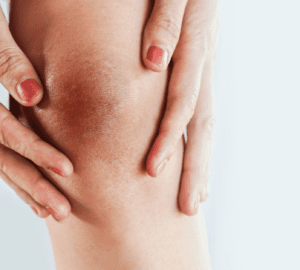In the realm of fitness, one exercise stands out for its simplicity and effectiveness – the wall sit. This unassuming yet powerful move has been a favorite among fitness enthusiasts and athletes alike.
In this blog post, we will delve deeper into the world of wall sits, exploring their remarkable benefits and providing you with a step-by-step walkthrough on how to perform them correctly.
So, grab a seat – against the wall, of course – and let’s uncover the wonders of wall sits.
13 Benefits of Wall Sits
Here are 13 reasons why you should consider adding wall sit exercises to your regular routine:
- Leg Strength
- Muscular Endurance
- Core Engagement
- Improved Posture
- Joint Health
- Calorie Burning
- Convenience
- No Equipment Needed
- Time Efficiency
- Bone Health
- Improved Circulation
- Enhanced Balance
- Low Impact
Leg Strength

At its core, the wall sit is a leg-strengthening powerhouse. It zeroes in on major leg muscles, including the quadriceps, hamstrings, and calf muscles. Regular practice leads to enhanced leg strength that can improve your performance in various activities.
Muscular Endurance

If you find yourself tiring quickly during physical endeavors, wall sits could be your solution. Engaging in regular wall sits can significantly enhance muscular endurance, enabling you to engage in prolonged activities without feeling fatigued.
Core Engagement

Don’t be deceived by its focus on the lower body – wall sits demand core engagement. Your abdominal and lower back muscles work hard to stabilize your body during the exercise, resulting in a stronger core over time.
Improved Posture

Modern lifestyles often contribute to poor posture, leading to discomfort and pain. Wall sits promote proper posture by engaging your core and encouraging spinal alignment, helping you stand tall and confident.
Joint Health

Healthy joints are crucial for maintaining an active lifestyle. Wall sits target knee and hip joint stability and flexibility, reducing the risk of injuries and promoting overall joint health.
Calorie Burning

If weight management is on your mind, wall sits can play a role. This bodyweight exercise burns calories, contributing to your weight loss or maintenance goals.
Also Read: Wide Rib Cage in Females: 5 Tips to Solve This Issue
Convenience

Whether you’re at home, in the office, or on the go, a wall is never too far away. Wall sits are remarkably convenient and can be performed virtually anywhere you find a wall.
No Equipment Needed

In a world filled with complex exercise equipment, wall sits are a refreshing exception. All you need is a wall and your determination.
Time Efficiency

In the midst of a busy schedule, finding time for exercise can be challenging. Wall sits come to the rescue with their time-efficient nature – a single set takes just a few minutes.
Bone Health

Strong bones are the foundation of a healthy body. Wall sits, as a weight-bearing exercise, contribute to improved bone density, reducing the risk of osteoporosis.
Improved Circulation

Prolonged sitting and inactivity can hamper blood circulation, leading to various health issues. Wall sits counteract this by promoting blood flow to your legs, potentially warding off conditions like varicose veins.
Enhanced Balance

Balancing on an invisible chair against the wall might sound unusual, but it works wonders for your balance and stability. As you perfect the art of wall sits, you’ll notice improved proprioception and coordination.
Low Impact

Joint problems needn’t deter you from exercise. Wall sits are low-impact, making them an excellent choice for individuals with joint sensitivities or those seeking a gentler workout option.
How to Do Wall Sits: A Step-by-Step Guide
Preparation

- Find a clear wall space with enough room for you to comfortably sit and slide down.
Starting Position

- Stand with your back against the wall.
- Feet should be shoulder-width apart or slightly farther.
- Keep your feet about 2 feet away from the wall.
- Your back and head should be flat against the wall.
Descending into the Wall Sit

- Slowly slide your back down the wall as you bend your knees.
- Lower your body until your thighs are parallel to the ground or until your knees form a 90-degree angle.
- Keep your heels flat on the ground, and ensure your knees are aligned with your toes.
- Maintain a straight back against the wall and engage your core.
Hold The Position

Also Read: What Are The Benefits Of Moon Charged-Water And How To Make
- Hold the wall sit position for a set amount of time (e.g., 20-60 seconds), or as long as you can maintain proper form.
- Focus on your breathing: inhale and exhale slowly and evenly.
Exiting the Wall Sit
- Push through your heels to slowly rise back up to the starting position.
- Keep your movements controlled and avoid rapid changes in posture.
Rest and Repeat
- Rest for a short period between sets if needed.
- Aim for 2-3 sets of wall sits, gradually increasing the duration as your strength improves.
Tips for Proper Form
- Ensure your back stays flush against the wall throughout the exercise.
- Keep your knees in line with your toes, not extending beyond them.
- Do not arch your lower back; engage your core to maintain a neutral spine.
- Avoid leaning too far forward or backward.
Variations and Progressions
- To increase the intensity, hold weights in your hands or place a stability ball between your back and the wall.
- Adjust the duration or number of sets based on your fitness level and goals.
Cool Down and Stretching
- After completing your wall sit workout, perform some gentle leg stretches to maintain flexibility and prevent muscle tightness.
Safety Precautions
- If you experience pain, discomfort, or have any existing health issues, consult a fitness professional or healthcare provider before attempting wall sits or any exercise.
Remember that proper form is crucial for getting the most out of the wall sit exercise and avoiding injury. Start with shorter durations and gradually increase as your strength improves over time.
What Happens if You do Wall sits Everyday?
Doing wall sits every day can lead to overworked muscles and potential strain. Muscles need time to recover and grow stronger. Frequent wall sits may not allow sufficient recovery, increasing the risk of injury. Instead, aim for balanced workout routines, incorporating rest days and varied exercises for overall muscle development and injury prevention. Consult a fitness professional for personalized guidance.
Conclusion
The humble wall sit holds a treasure trove of benefits that can transform your fitness journey. From stronger legs to improved posture and joint health, this exercise offers it all. Armed with our detailed guide on proper execution, you’re ready to embrace the wall sit and embark on a path to enhanced strength, endurance, and overall well-being. So, put your back against the wall and let the wall sit revolution begin!
FAQs
Wall sits are an exercise where you sit against a wall with knees bent. They strengthen muscles like quads, hamstrings, and core through static contraction.
Yes, wall sits suit various fitness levels. Beginners start with short holds and progress, while advanced can add weights. Consult a pro if you have health concerns.
Beginners: 20-30 sec, Advanced: 60 sec or more. Aim for 2-3 sessions per week, allowing recovery.
They contribute to calorie burn and muscle gain, potentially supporting weight management. Combine with cardio and a balanced diet.
Avoid arching back, knees over toes, and leaning. Keep back against wall, engage core, align knees with toes. If unsure, seek professional guidance.



